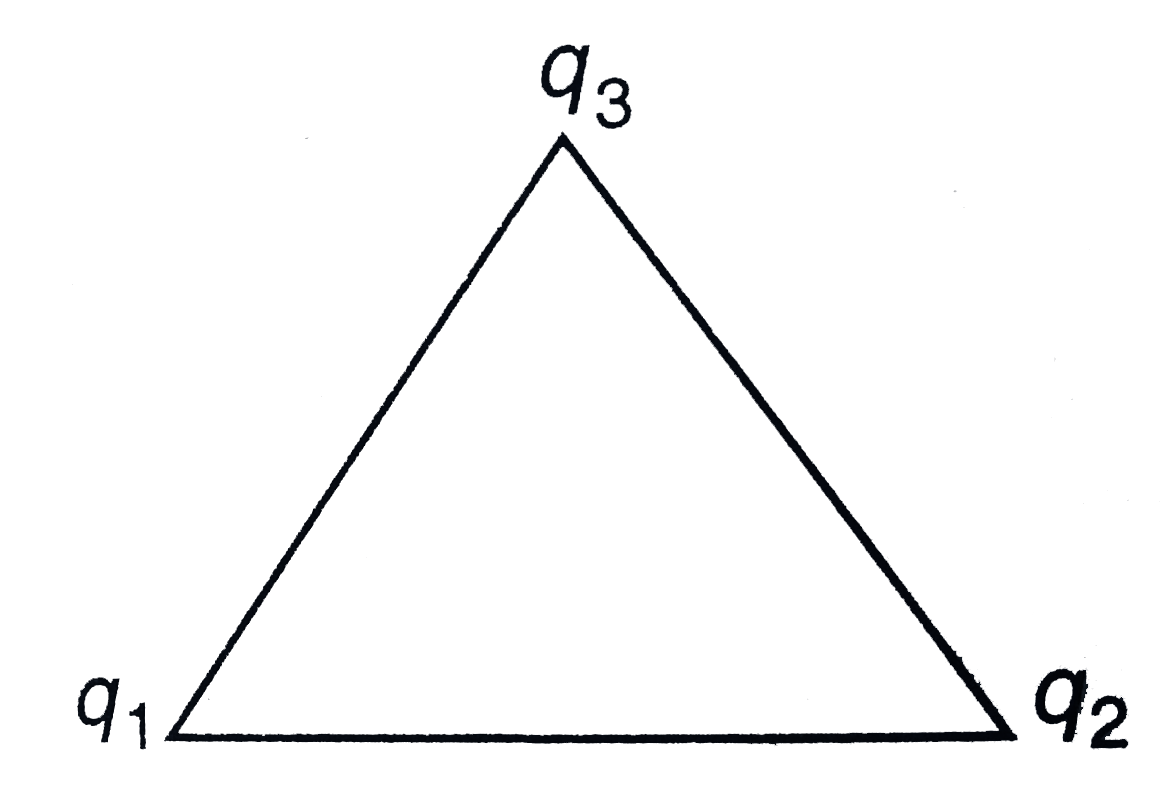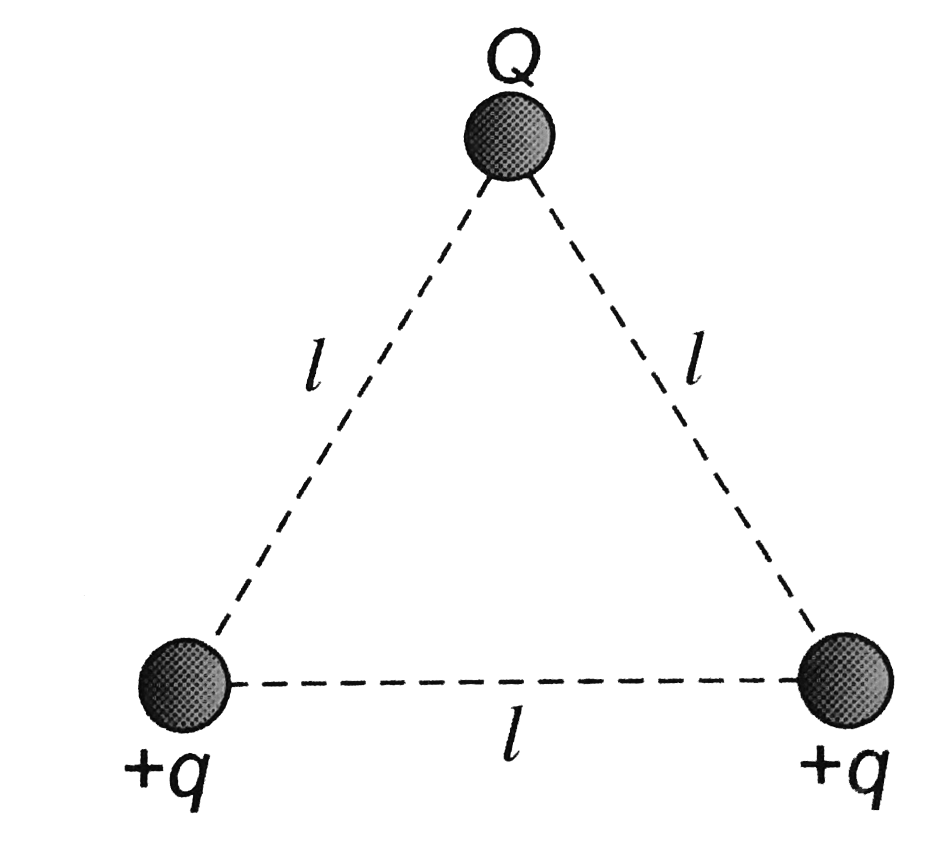Three charges are placed at the vertices of an equilateral triangle of side 10 cm. Assume q1=1μC,q2=−2μCandq3=4μC. Work done in separating the charges to infinity is
−4.5J
4.5J
45 J
None of these
The correct Answer is:D
To find the work done in separating the charges q1=1μC, q2=−2μC, and q3=4μC placed at the vertices of an equilateral triangle with a side length of 10cm, we will calculate the potential energy of the system and then determine the work done in separating them to infinity.
Step 1: Understand the potential energy formula
The potential energy U of a system of point charges is given by the formula:
U=k∑i<jqiqjrij
where k is Coulomb's constant (k=9×109Nm2/C2), qi and qj are the charges, and rij is the distance between the charges.
Step 2: Identify the distances and charges
For an equilateral triangle with side length r=10cm=0.1m:
- The pairs of charges are (q1,q2), (q2,q3), and (q3,q1).
Step 3: Calculate potential energy for each pair
1. Potential Energy between q1 and q2:
U12=kq1q2r=9×109(1×10−6)(−2×10−6)0.1=−1.8×10−2J
2. Potential Energy between q2 and q3:
U23=kq2q3r=9×109(−2×10−6)(4×10−6)0.1=−7.2×10−2J
3. Potential Energy between q3 and q1:
U31=kq3q1r=9×109(4×10−6)(1×10−6)0.1=3.6×10−2J
Step 4: Sum the potential energies
Now, we sum the potential energies to find the total potential energy U:
U=U12+U23+U31
U=(−1.8×10−2)+(−7.2×10−2)+(3.6×10−2)=−5.4×10−2J
Step 5: Work done in separating the charges
The work done W in separating the charges to infinity is equal to the negative of the total potential energy:
W=−U=5.4×10−2J=0.054J
Final Answer
The work done in separating the charges to infinity is:
0.054J
The potential energy U of a system of point charges is given by the formula:
U=k∑i<jqiqjrij
where k is Coulomb's constant (k=9×109Nm2/C2), qi and qj are the charges, and rij is the distance between the charges.
For an equilateral triangle with side length r=10cm=0.1m:
- The pairs of charges are (q1,q2), (q2,q3), and (q3,q1).
1. Potential Energy between q1 and q2:
U12=kq1q2r=9×109(1×10−6)(−2×10−6)0.1=−1.8×10−2J
U23=kq2q3r=9×109(−2×10−6)(4×10−6)0.1=−7.2×10−2J
U31=kq3q1r=9×109(4×10−6)(1×10−6)0.1=3.6×10−2J
Now, we sum the potential energies to find the total potential energy U:
U=U12+U23+U31
U=(−1.8×10−2)+(−7.2×10−2)+(3.6×10−2)=−5.4×10−2J
The work done W in separating the charges to infinity is equal to the negative of the total potential energy:
W=−U=5.4×10−2J=0.054J
The work done in separating the charges to infinity is:
0.054J
Topper's Solved these Questions
- ELECTROSTATIC POTENTIAL AND CAPACITORSBOOK - DC PANDEY ENGLISHCHAPTER - ELECTROSTATIC POTENTIAL AND CAPACITORSEXERCISE - (B) Chapter exercises
17 Videos
- ELECTROSTATIC POTENTIAL AND CAPACITORSBOOK - DC PANDEY ENGLISHCHAPTER - ELECTROSTATIC POTENTIAL AND CAPACITORSEXERCISE - (C) Chapter exercises
50 Videos
- ELECTROSTATIC POTENTIAL AND CAPACITORSBOOK - DC PANDEY ENGLISHCHAPTER - ELECTROSTATIC POTENTIAL AND CAPACITORSEXERCISE - Check point 2.5
20 Videos
- ELECTROMAGNETIC WAVESBOOK - DC PANDEY ENGLISHCHAPTER - ELECTROMAGNETIC WAVESEXERCISE - Sec C
22 Videos
- ELECTROSTATICSBOOK - DC PANDEY ENGLISHCHAPTER - ELECTROSTATICSEXERCISE - Medical entrances gallery
37 Videos
Similar Questions
Three charges 2q,−q,and−q are located at the vertices of an equilateral triangle. At the center of the triangle,
View SolutionIn the given figure, there are four point charges placed at the vertices of a square of side, a=1.4m. If q1=+18nC,q2=−24nC,q3+35nCandq4=+16nCm then find the electric at the centre P of the square Assume the potential to be zero at infinity.

View Solution
Knowledge Check
Consider the charges q,q and -q placed at the vertices of an equilateral triangle of each side l. What is the force on each charge ?
Aq24√2πε0l2B−q24πε0l2Cq24πε0l2Dzero
Three points charges of 1C,2Cand3C are placed at the corners of an equilateral triangle of side 100 cm. Find the work done to move these charges to the corners of a similar equilateral triangle of side 50 cm.
View SolutionThree points charges of 1C,2Cand3C are placed at the corners of an equilateral triangle of side 100 cm. Find the work done to move these charges to the corners of a similar equilateral triangle of side 50 cm.
View SolutionThree point charges q are placed at three vertices of an equilateral triangle of side a. Find magnitude of electric force on any charge due to the other two.
View SolutionThree charges q1=1μC,q2=2μC and q3=3μC are placed on the vertices of an equilateral triangle of side 1.0 m. Find the net electric force acting on charge q1

View SolutionThree charges Q,(+q) and (+q) are placed at the vertices of an equilateral triangle of side l as shown in the figure. It the net electrostatic energy of the system is zero, then Q is equal to

View SolutionThree charges Q,(+q) and (+q) are placed at the vertices of an equilateral triangle of side l as shown in the figure. It the net electrostatic energy of the system is zero, then Q is equal to

View SolutionThree equal charge q0 each are placed at three corners of an equilateral triangle of side 'a'. Find out force acting on one of the charge due to other two charges ?
View Solution
